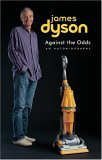 Against the Odds: An Autobiography by James Dyson
Against the Odds: An Autobiography by James Dyson
My rating: 5 of 5 stars
I have long been a fan of the Dyson vacuums because they worked better than anything I have ever heard of (though I’ve yet to get one). Thus, when I saw this book sitting calmly on the library shelf, I reached out to it in wonder. I knew that Dyson raised himself from practically nothing, yet became a force to be reckoned with in the world of vacuums. I was curious as to the more in-depth story behind it. What I got was that as well as a touching insight to the depth of character, intellect, and sheer bull-headedness it takes to succeed in a world of cut-throats.
Dyson writes in a no-nonsense, tongue-in-cheek sort of way. I confess, I found myself laughing out loud more than once. Besides making those stare at me in confusion, I would share with them parts of the Dyson story on the plane, in cafes, and where ever else I found a few moments to read the book. Sharing just a few paragraphs of this work would make others smile and become interested in the man and the machine as well. Yes, it is that well written.
But, is it an autobiography about the man, the machines or the company? It’s hard to separate one from the other, honestly. Dyson is the machine and the beating heart of the company. Yet, he seems to be driven by an utter hatred of dust and debris and love of the wonderful vacuum that can get rid of it. So, in the end, the book is about all three. Dyson starts off telling a little bit about himself which explains his driving need to succeed, as well as his love of design. He then continues on to tell of his misfortunes in university life and his stumbling through until he found his calling as a designer that learns engineering on the side. He explains how Jeremy Fry paved the way for an unconventional, honest, and very good way of doing engineering and design, which Dyson makes his own today in Dyson Appliances. And then, the story really takes off.
At this point you start to realise that Dyson is more than just an average person. He’s an average person with stubborn willfulness that can make beautiful, functional, and practical roll into one thing. This starts with the Ballbarrow, which is a redesign of the dysfunctional wheelbarrow. It’s made to work much easier across an array of ground without getting stuck in the mud, not rust, and actually hold things within it so the items being transported don’t slosh about. During the time he successfully makes this a business, he learns painful lessons about business partners and untrustworthy snake oils salesmen. When he recounts the tale, it is with the honesty of someone that has been there, suffered through, and is stronger for it all.
Only after this setup do we get to the epic tale of the vacuum. And, I do mean epic. The tale ranges all around the globe from Japan to Canada, America and finally back to Europe. It ranges from drudgery of starting out, fighting through realms of cut throat bastard business people that try to cheat and steal (and in some cases do) to a final nearly fairy tale like success at the end. Throughout it all, though, Dyson pulls no punches. He tells you straight what it was like, what he had to endure, and that the only way it worked is because he ground his heels in and worked through it.
Throughout the book, Dyson reminds you that it’s function and form over cheesy, grotesque advertising that make a product worth it. He reminds you that it’s hard work, not a magic pill that will see it through to the end. He also reminds you that breaking the mould is often times better than being a copied part of the system. Being unique is a strength in business from the first ideas through the sweat and tears to the happy ending.
Takeaways
There are lots of takeaways for inventors in this book. Chief among them is that invention is not easy. It’s a lot of hard work, and the smaller you are, the harder it is. Dyson tells his part of the story where big corporations that he turned to when he wanted to put things on the market tried to use him and spit him back out again. However, he did it. He also did it without a patent company that does all the work for you. It is possible to do dream and make it without selling your vision and dreams to others. It just takes a lot of work and stubbornness.
This book was very inspirational as a how to invent, protect your ideas, and become a successful inventor. It’s also a great book for running a successful business based on truth, not gimmicks. I will be purchasing a copy of this book for the Insanitek library, and quoting from it often when people ask for advice.